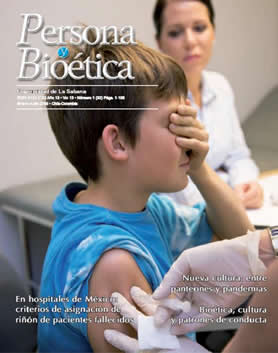And care in end-of-life situations: proportional and paliative care
Keywords:
End of life, curing, proportionate, artifi cial support therapy, suspension of treatment, quality of life, palliative care.Abstract
An effort to address the bioethical issues inherent in the process of dying requires a focus on the proportional aspect of treatment. Failing to bear in mind the intrinsic limit to the art of medicine can result in dual and contradictory behavior: artifi cial support therapy on the one hand and therapeutic abandonment on the other. In real situations, the inability to recognize the limits of the power of medicine is, in one way or another, equivalent to not accepting death, to denying its inevitable role or to evading its anthropological and existential complexity. Moreover, denying that limit can lead to a possible confl ict between the physician and the patient, resulting in medicine that is defensive and contractual in nature.
The proportionality in question is a criterion and, as such, it demands a particular assessment of the situation, without rigid and dogmatic codifi cation. However, the reluctance that exists at the social level or within the medical scientifi c community to accept suspension of treatment when it is shown to be disproportionate is born of the conceptual confusion between unlawful death and permitting death; that is, between omission and suspension. The difference between these two acts disappears only if the weight of the assessment is shifted to the intention or the consequences, the oneness of which would unite the moral equivalent of the acts. The article also shows the relationship between treatment and quality of life and the important fi eld of palliative care.
Downloads
How to Cite
Issue
Section
License
Authors who publish with this journal agree to the following terms:
This journal and its papers are published with the Creative Commons License Attribution-NonCommercial-NoDerivatives 4.0 International (CC BY-NC-ND 4.0). You are free to share copy and redistribute the material in any medium or format if you: give appropriate credit, provide a link to the license, and indicate if changes were made; don’t use our material for commercial purposes; don’t remix, transform, or build upon the material.





